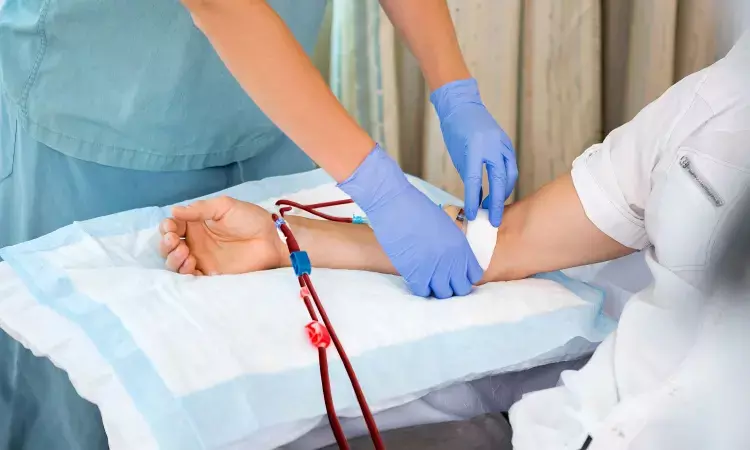- Home
- Medical news & Guidelines
- Anesthesiology
- Cardiology and CTVS
- Critical Care
- Dentistry
- Dermatology
- Diabetes and Endocrinology
- ENT
- Gastroenterology
- Medicine
- Nephrology
- Neurology
- Obstretics-Gynaecology
- Oncology
- Ophthalmology
- Orthopaedics
- Pediatrics-Neonatology
- Psychiatry
- Pulmonology
- Radiology
- Surgery
- Urology
- Laboratory Medicine
- Diet
- Nursing
- Paramedical
- Physiotherapy
- Health news
- Fact Check
- Bone Health Fact Check
- Brain Health Fact Check
- Cancer Related Fact Check
- Child Care Fact Check
- Dental and oral health fact check
- Diabetes and metabolic health fact check
- Diet and Nutrition Fact Check
- Eye and ENT Care Fact Check
- Fitness fact check
- Gut health fact check
- Heart health fact check
- Kidney health fact check
- Medical education fact check
- Men's health fact check
- Respiratory fact check
- Skin and hair care fact check
- Vaccine and Immunization fact check
- Women's health fact check
- AYUSH
- State News
- Andaman and Nicobar Islands
- Andhra Pradesh
- Arunachal Pradesh
- Assam
- Bihar
- Chandigarh
- Chattisgarh
- Dadra and Nagar Haveli
- Daman and Diu
- Delhi
- Goa
- Gujarat
- Haryana
- Himachal Pradesh
- Jammu & Kashmir
- Jharkhand
- Karnataka
- Kerala
- Ladakh
- Lakshadweep
- Madhya Pradesh
- Maharashtra
- Manipur
- Meghalaya
- Mizoram
- Nagaland
- Odisha
- Puducherry
- Punjab
- Rajasthan
- Sikkim
- Tamil Nadu
- Telangana
- Tripura
- Uttar Pradesh
- Uttrakhand
- West Bengal
- Medical Education
- Industry
Hemodialysis shows similar survival rates as peritoneal dialysis for ESRD

Hemodialysis (HD) and peritoneal dialysis (PD) not significantly different regarding survival in patients being treated for end-stage renal disease (ESRD). A recent comprehensive study, published in the BMC Nephrology analyzed the impact of the initial dialysis modality on patient survival.
The study was a part of the Chinese National Renal Data System (CNRDS), meticulously analyzed the outcomes of 739 ESRD patients from 2010 to 2018. Through rigorous propensity score matching to balance baseline conditions, 125 PD patients were matched with 125 HD patients for a detailed comparison.
The results of this study revealed intriguing insights of the survival rates of patients over one, two, and three years. In the HD group, survival rates were 96.5%, 90.7%, and 82.5%, respectively, while the PD group exhibited higher rates of 99.5%, 97.8%, and 92.5%. Also, among the propensity score-matched cohorts, no significant differences in survival were observed.
The multivariate analysis, adjusting for various baseline characteristics, identified factors like the age at dialysis initiation, Charlson Comorbidity Index (CCI), congestive heart failure, and cerebrovascular disease as significant risk factors affecting survival.
A significant finding emerged when the study delved into subgroups based on diabetes status. The Kaplan–Meier survival curve showcased a significant advantage for PD over HD in diabetic ESRD patients, it further emphasized a potential nuance in treatment outcomes based on underlying health conditions.
The implications of this study suggest that, HD and PD exhibit comparable survival rates for ESRD patients on a broader scale. This superior survival observed in diabetic patients undergoing PD prompts further investigation into tailored treatment approaches.
This study adds a valuable layer of nuanced understanding between the intricate interplay between dialysis modalities, comorbidities, and survival rates to underscores the complexity of renal care decisions. Further research is warranted to refine these findings and guide clinicians in delivering personalized and effective treatment for ESRD patients.
Source:
Liu, L., Pang, J., Xu, J., Liu, L., Liao, M., Huang, Q., & Li, Y. (2023). Impact of initial dialysis modality on the survival of patients with ESRD: a propensity-score-matched study. In BMC Nephrology (Vol. 24, Issue 1). Springer Science and Business Media LLC. https://doi.org/10.1186/s12882-023-03312-0
Neuroscience Masters graduate
Jacinthlyn Sylvia, a Neuroscience Master's graduate from Chennai has worked extensively in deciphering the neurobiology of cognition and motor control in aging. She also has spread-out exposure to Neurosurgery from her Bachelor’s. She is currently involved in active Neuro-Oncology research. She is an upcoming neuroscientist with a fiery passion for writing. Her news cover at Medical Dialogues feature recent discoveries and updates from the healthcare and biomedical research fields. She can be reached at editorial@medicaldialogues.in
Dr Kamal Kant Kohli-MBBS, DTCD- a chest specialist with more than 30 years of practice and a flair for writing clinical articles, Dr Kamal Kant Kohli joined Medical Dialogues as a Chief Editor of Medical News. Besides writing articles, as an editor, he proofreads and verifies all the medical content published on Medical Dialogues including those coming from journals, studies,medical conferences,guidelines etc. Email: drkohli@medicaldialogues.in. Contact no. 011-43720751


